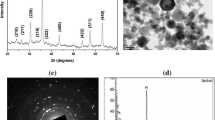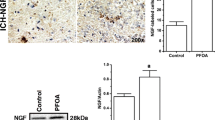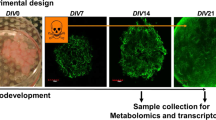Abstract
Perfluorooctanoic acid (PFOA) is a member of Per- and polyfluoroalkyl substances (PFASs), an industrial pollutant that has been produced for decades and widely used in various industries. Accumulation of this compound in the environment and body of organisms led to increased concerns about this compound. The toxic effects of PFOA on the nervous system are unknown yet. We aimed to assess the myelination and neurogenesis in brain tissue. In this study, PFOA at doses of 1, 5, 10, and 20 mg/kg were injected intraperitoneally into C57BL/6 J mice for 14 days, and the myelin content, CD4 + and CD8 + cell infiltration to brain regions were evaluated. Also, bromodeoxyuridine (BrdU) labeling was performed to compare neurogenesis among the groups. Luxol Fast Blue (LFB) staining revealed a significant decrease in myelin content in both sex at high concentrations (p < 0.001). The BrdU incorporation changes were observed in both sexes especially females which was highly related to the dose of PFOA and region of the brain. The infiltration rates of CD4 + and CD8 + cells to the brain were shown to be decreased; meanwhile the lymphocyte count was not significantly changed among groups over time and vice versa for the monocyte and neutrophils. Our results showed that PFOA had a negative impact on neurogenesis and the myelination process through the specific region of the brain depending on the dose and sex. Also, PFOA could disturb the number of CD4 + and CD8 + cells infiltrating the brain, which plays a crucial role in neurogenesis, leading to toxicity and neurological abnormalities. It seems that more research is needed to determine the exact mechanisms of PFOA neurotoxicity and its long-term behavioral consequences.
Graphical Abstract








Similar content being viewed by others
Data availability
All data will be available if it needed.
Change history
14 August 2023
A Correction to this paper has been published: https://doi.org/10.1007/s00210-023-02630-2
References
Aliomrani M, Mesripour A, Mehrjardi AS (2022) Creatine and Alpha-lipoic acid antidepressant-like effect following cyclosporine A administration. Turkish J Pharm Sci 19(2):196
Arbuckle TE, MacPherson S, Foster WG, Sathyanarayana S, Fisher M, Monnier P et al (2020) Prenatal perfluoroalkyl substances and newborn anogenital distance in a Canadian cohort. Reprod Toxicol 94:31–39
Barry V, Darrow LA, Klein M, Winquist A, Steenland K (2014) Early life perfluorooctanoic acid (PFOA) exposure and overweight and obesity risk in adulthood in a community with elevated exposure. Environ Res 132:62–69
Brieger A, Bienefeld N, Hasan R, Goerlich R, Haase H (2011) Toxicology in vitro impact of perfluorooctanesulfonate and perfluorooctanoic acid on human peripheral leukocytes. Toxicol Vitr 25(4):960–968
Caron-Beaudoin É, Ayotte P, Blanchette C, Muckle G, Avard E, Ricard S, et al. (2020) Perfluoroalkyl acids in pregnant women from Nunavik (Quebec, Canada): trends in exposure and associations with country foods consumption. Environ Int. 145(xxxx)
Chen X, Nie X, Mao J, Zhang Y, Yin K, Jiang S (2018) Perfluorooctanesulfonate induces neuroinflammation through the secretion of TNF-α mediated by the JAK2/STAT3 pathway. Neurotoxicology 66:32–42
Chen X, Nie X, Mao J, Zhang Y, Yin K, Sun P, et al. (2018) Perfluorooctane sulfonate mediates secretion of IL-1β through PI3K/AKT NF-кB pathway in astrocytes. Neurotoxicol Teratol. (2017) :#pagerange#
Chenari J, Golshan-Iranpour F, Ghasemi N (2021) The effect of exposure to perfluorooctanoic acid during pregnancy on myelin density of corpus callosum of newborn rat. J Isfahan Med Sch 39(630):464–469
Cui L, Liao ÆQZÆC, Jiang JFÆG (2009) Studies on the toxicological effects of PFOA and PFOS on rats using histological observation and chemical analysis (November 2006):338–49
Danesh-Seta T, Emami F, Nasr-Esfahani MH, Ghaedi K, Aliomrani M (2021) Bee venom–derived BBB shuttle and its correlation with oligodendrocyte proliferation markers in mice model of multiple sclerosis. Neurotox Res. 1–8
de Miranda AS, Zhang C-J, Katsumoto A, Teixeira AL (2017) Hippocampal adult neurogenesis: does the immune system matter? J Neurol Sci 372:482–495
DeWitt JC, Copeland CB, Strynar MJ, Luebke RW (2008) Perfluorooctanoic acid-induced immunomodulation in adult C57BL/6J or C57BL/6N female mice. Environ Health Perspect 116(5):644–650
DeWitt JC, Blossom SJ, Schaider LA (2019) Exposure to per-fluoroalkyl and polyfluoroalkyl substances leads to immunotoxicity: epidemiological and toxicological evidence. J Expo Sci Environ Epidemiol 29(2):148–156
Fares J, Bou Diab Z, Nabha S, Fares Y (2019) Neurogenesis in the adult hippocampus: history, regulation, and prospective roles. Int J Neurosci 129(6):598–611
Girardi P, Merler E (2019) A mortality study on male subjects exposed to polyfluoroalkyl acids with high internal dose of perfluorooctanoic acid. Environ Res 179(September):108743
Goya RL, Tyers P, Barker RA (2010) Adult neurogenesis is unaffected by a functional knock-out of MHC class I in mice. NeuroReport 21(5):349–353
Hu Q, Franklin JN, Bryan I, Morris E, Wood A, DeWitt JC (2012) Does developmental exposure to perfluorooctanoic acid (PFOA) induce immunopathologies commonly observed in neurodevelopmental disorders? Neurotoxicology 33(6):1491–1498
Kleinman MT, Stevenson ED (2021) Introduction to the 51st Annual A&WMA critical review: PFOA and cancer. Vol. 71, Journal of the Air and Waste Management Association. Taylor & Francis; p. 661–2
Li R, Guo C, Tse WKF, Su M, Zhang X, Lai KP (2020) Metabolomic analysis reveals metabolic alterations of human peripheral blood lymphocytes by perfluorooctanoic acid. Chemosphere 239:124810
Liang L, Pan Y, Bin L, Liu Y, Huang W, Li R, et al. (2021) Immunotoxicity mechanisms of perfluorinated compounds PFOA and PFOS. Chemosphere. 132892
Liu G, Dhana K, Furtado JD, Rood J, Zong G, Liang L, et al. (2018) Perfluoroalkyl substances and changes in body weight and resting metabolic rate in response to weight-loss diets : a prospective study. 1–21
Mariussen E (2012) Neurotoxic effects of perfluoroalkylated compounds : mechanisms of action and environmental relevance. 1968:1349–67
Mashayekhi V, Haj K, Ebrahim M, Hashemzaei M, Tabrizian K, Shahraki J, et al. (2015) Mechanistic approach for the toxic effects of perfluorooctanoic acid on isolated rat liver and brain mitochondria
Mazloumfard F, Mirian M, Eftekhari S-M, Aliomrani M (2020) Hydroxychloroquine effects on miR-155–3p and miR-219 expression changes in animal model of multiple sclerosis. Metab Brain Dis. 1–9
Midgett K, Peden-Adams MM, Gilkeson GS, Kamen DL (2015) In vitro evaluation of the effects of perfluorooctanesulfonic acid (PFOS) and perfluorooctanoic acid (PFOA) on IL-2 production in human T-cells. J Appl Toxicol 35(5):459–465
Mohammadi-Rad M, Ghasemi N, Aliomrani M (2019) Evaluation of apamin effects on myelination process in C57BL/6 mice model of multiple sclerosis. Res Pharm Sci 14(5)
Naffaa V, Lapr O, Schang A (2021) Neurotoxicology effects of endocrine disrupting chemicals on myelin development and diseases. 83(December 2020):51–68
Osemwegie O, Smith E (2021) Effects of in vitro exposure of perfluorooctanoic acid and monocrotophos on astroglia SVG p12 cells. (September 2020):1–10
Pecquet AM, Maier A, Kasper S, Sumanas S, Yadav J (2020) Exposure to perfluorooctanoic acid (PFOA) decreases neutrophil migration response to injury in zebrafish embryos. BMC Res Notes 13(1):4–9
Qazi MR, Xia Z, Bogdanska J, Chang S-C, Ehresman DJ, Butenhoff JL et al (2009a) The atrophy and changes in the cellular compositions of the thymus and spleen observed in mice subjected to short-term exposure to perfluorooctanesulfonate are high-dose phenomena mediated in part by peroxisome proliferator-activated receptor-alpha (PPARα). Toxicology 260(1–3):68–76
Qazi MR, Bogdanska J, Butenhoff JL, Nelson BD, DePierre JW, Abedi-Valugerdi M (2009b) High-dose, short-term exposure of mice to perfluorooctanesulfonate (PFOS) or perfluorooctanoate (PFOA) affects the number of circulating neutrophils differently, but enhances the inflammatory responses of macrophages to lipopolysaccharide (LPS) in a similar fashion. Toxicology 262(3):207–214
Rashid F, Ahmad S, Irudayaraj JMK (2020) Effect of perfluorooctanoic acid on the epigenetic and tight junction genes of the mouse intestine. Toxics 8(3):64
Salimi A, Nikoosiar Jahromi M, Pourahmad J (2019) Maternal exposure causes mitochondrial dysfunction in brain, liver, and heart of mouse fetus: an explanation for perfluorooctanoic acid induced abortion and developmental toxicity. Environ Toxicol 34(7):878–885
Shane HL, Baur R, Lukomska E, Weatherly L, Anderson SE (2020) Immunotoxicity and allergenic potential induced by topical application of perfluorooctanoic acid ( PFOA ) in a murine model. Food Chem Toxicol 136(January):111114
Sharifan A, Etebari M, Zolfaghari B, Aliomrani M. Investigating the effects of bark extract and volatile oil of Pinus eldarica against cisplatin-induced genotoxicity on HUVECs cell line. Toxicol Res (Camb)
Shen CY, Weng JC, Tsai JD, Su PH, Chou MC, Wang SL (2021) Prenatal exposure to endocrine-disrupting chemicals and subsequent brain structure changes revealed by voxel-based morphometry and generalized q-sampling mri. Int J Environ Res Public Health 18(9):1–16
Shi L, Zheng J, Yan S, Li Y, Wang Y, Liu X et al (2020) Exposure to perfluorooctanoic acid induces cognitive deficits via altering gut microbiota composition, impairing intestinal barrier integrity, and causing inflammation in gut and brain. J Agric Food Chem 68(47):13916–13928
Song EJ, Jeon SG, Kim KA, Kim J, Moon M (2017) Restricted CD4+ T cell receptor repertoire impairs cognitive function via alteration of Th2 cytokine levels. Neurogenesis 4(1):e1256856
Steenland K, Fletcher T, Savitz DA (2010) Epidemiologic evidence on the health effects of perfluorooctanoic acid (PFOA). Environ Health Perspect 118(8):1100–1108
Sundukov YN (2006) First record of the ground beetle Trechoblemus postilenatus (Coleoptera, Carabidae) in Primorskii krai. Far East Entomol 165(April):16
Tamm C, Ceccatelli S (2017) Mechanistic insight into neurotoxicity induced by developmental insults. Vol. 482, Biochemical and Biophysical Research Communications. Elsevier Ltd; p. 408–18
Tukker AM, Bouwman LMS, van Kleef RGDM, Hendriks HS, Legler J, Westerink RHS (2020) Perfluorooctane sulfonate (PFOS) and perfluorooctanoate (PFOA) acutely affect human α1β2γ2L GABAA receptor and spontaneous neuronal network function in vitro. Sci Rep 10(1):1–14
Wang W, Cohen JA, Wallrapp A, Trieu KG, Barrios J, Shao F et al (2019) Age-related dopaminergic innervation augments T helper 2-type allergic inflammation in the postnatal lung. Immunity 51(6):1102-1118.e7
Wang C, Nie X, Zhang Y, Li T, Mao J, Liu X, et al. (2015) Reactive oxygen species mediate nitric oxide production through ERK/JNK MAPK signaling in HAPI microglia after PFOS exposure. Toxicol Appl Pharmacol
Yang Q, Xie Y, Depierre JW (2000) Effects of peroxisome proliferators on the thymus and spleen of mice. Clin Exp Immunol 122(2):219–226
Yang Q, Xie Y, Eriksson AM, Nelson BD, Depierre JW (2001) Further evidence for the involvement of inhibition of cell proliferation and development in thymic and splenic atrophy induced by the peroxisome proliferator perfluoroctanoic acid in mice. 62:1133–40
Zarif H, Nicolas S, Guyot M, Hosseiny S, Lazzari A, Canali MM et al (2018) CD8 + T cells are essential for the effects of enriched environment on hippocampus-dependent behavior, hippocampal neurogenesis and synaptic plasticity. Brain Behav Immun 69:235–254
Zheng G, Schreder E, Dempsey JC, Uding N, Chu V, Andres G et al (2021) Per-and polyfluoroalkyl substances (PFAS) in breast milk: concerning trends for current-use PFAS. Environ Sci Technol 55(11):7510–7520
Funding
This study was supported by a grant (Project No. 199680) from Isfahan Pharmaceutical Science Research Center, Isfahan University of Medical Sciences, Isfahan, Iran.
Author information
Authors and Affiliations
Contributions
AK and MAO conceived of the presented idea, AK and MK carried out the experiment, MS processed the results and prepared the manuscript, MAO supervise the project, all authors provided critical feedback and helped shape the research, analysis and manuscript.
Corresponding author
Ethics declarations
Ethics approval
All procedures were approved by the Iran National Committee for Ethics in Biomedical Research (IR.MUI.RESEARCH.REC.1400.025) which was performed in accordance with the Guidelines for the Care and Use of Laboratory Animals.
Competing interests
All authors declare no conflict of interest.
Additional information
Publisher's note
Springer Nature remains neutral with regard to jurisdictional claims in published maps and institutional affiliations.
Rights and permissions
Springer Nature or its licensor (e.g. a society or other partner) holds exclusive rights to this article under a publishing agreement with the author(s) or other rightsholder(s); author self-archiving of the accepted manuscript version of this article is solely governed by the terms of such publishing agreement and applicable law.
About this article
Cite this article
Neisiani, A.K., Mousavi, M.K., Soltani, M. et al. Perfluorooctanoic acid exposure and its neurodegenerative consequences in C57BL6/J mice. Naunyn-Schmiedeberg's Arch Pharmacol 396, 2357–2367 (2023). https://doi.org/10.1007/s00210-023-02387-8
Received:
Accepted:
Published:
Issue Date:
DOI: https://doi.org/10.1007/s00210-023-02387-8




